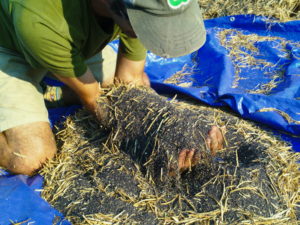Cultivating the Heirlooms of Tomorrow
Whether you plant seeds or not!
Do you breed new vegetable varieties? Do you save seed? Do you wear clothes and eat food?
If you answered ‘yes’ to any of these questions, you impact our food system at the seed level profoundly. Every day we make decisions that influence what seeds will — and will not — be sown by future generations.
Few people are plant breeders by profession. But if you’ve saved seed, you are a plant breeder: decisions you’ve made (consciously and sub-conciously) have changed the seeds available 10, 100 and 10,000 years from now. And every time you buy clothes and eat food you are influencing the decisions of professional seed breeders who determine what seeds are being planted around the world.
Like a seed, you have more power to change the world than perhaps you’ll ever know.
How do heirlooms matter? There are many definitions of an ‘heirloom’ variety; I think of an heirloom as a plant whose seeds have been saved in a general region for more than 40 years. Heirlooms have become popular for many reasons and have much to offer us: phenomenal flavor, regional adaptation and cultural acuity. Recently bred varieties tend to focus on productivity and transportability, often leaving flavor out of the equation. So of course we are turning to heirlooms for flavor and connection to our seed heritage.
But consider: each ‘heirloom’ variety originally began as a brand new variety. Only after generations of people selecting, saving and sharing these seeds did they become the beloved heirlooms of today. Selected well over generations, these varieties will continue to become more delicious and resilient for future generations.
Who is selecting our heirlooms to be more delicious, more resilient? You can.
Who is breeding the new varieties that our Grandchildren will know as ‘heirloom’? You can.
Our modern food crops were developed originally by amateurs, by grandparents and their grandparents before them for thousands of years. Professional seed breeders have only been around for a fraction of the time we’ve been saving seeds as a species. Though modern professional plant breeders are often highly educated, don’t underestimate the significance of your observation and selection in your garden.
You can select heirlooms to be more delicious and more resilient; simply choose which plants’ seeds you’ll save on a basis of simple observation. Do some tomatoes not get blight? Save those. Do some heads of lettuce bolt after most of the others? Save those. Do some winter squash keep longer than others? Save those. It’s all a matter of personal preference and genetic diversity offers us the range of possibilities. Only our imaginations are the limit. For example, Caroline Hunt and her family have been saving Amish Butter Popcorn for just over a decade. “You’ll be surprised how quickly you can work with a population and see measurable change,” she notes. At Italy Hill Farm in the Finger Lakes of New York, Caroline selects for excellent popping, long conical ears with a small butt (easier to shell), drought tolerance and corn earworm resistance. Over the years, her seed has dramatically improved and as these qualities have stabilized, further refinements are made. It is a testament to the power of observation, selection, dedication and vision of amateur seed savers who are making heirlooms more delicious, productive and resilient than ever.
You can breed the new varieties that your grandchildren will know as heirloom. “If you’re already saving seeds,” writes Carol Deppe in her book Breed Your Own Vegetable Varieties, “you’re just a few short steps away from deliberately breeding plants. Why limit yourself to preserving the achievements of the amateurs of the past? They didn’t. You can both preserve the fine old heirloom varieties and use them to create new varieties of your own.”

This “Red Russian” Kale has been selected for countless generations and will continue to be selected for countless to come. What qualities would you select kale for now that future generations will thank you for? Photo by Petra Page-Mann
For example, Will Bonsall has long stewarded and bred phenomenal varieties of all kinds of plants on his homestead in Maine. Several years ago he crossed two heirloom tomatoes, Gardener’s Delight (cherry) and Royal Chico (paste), discovering a gem in the progeny: vigorous plants covered in bright red, heart-shaped tomatoes, early to fruit and delectable as they were endearing. After five seasons of selection, “Gardener’s Sweetheart” was just introduced in 2014. A new variety, by the time our children’s children have their children, Gardener’s Sweetheart will be a beloved heirloom alongside any classic heirloom tomato we now know and love.


With the onslaught of GMOs threatening bees, monarch butterflies and birds….not to mention the yet-to-be-determined impact on ground water, I see your efforts as life-saving for future generations.
How do we stop GMO corn/soy from impacting on the purity of “natural” seeds for the future? Your insight and dedication I’m sure will make a HUGE difference. Please address this issue in future articles.
with deepest thanks in advance,
Ed McMillen